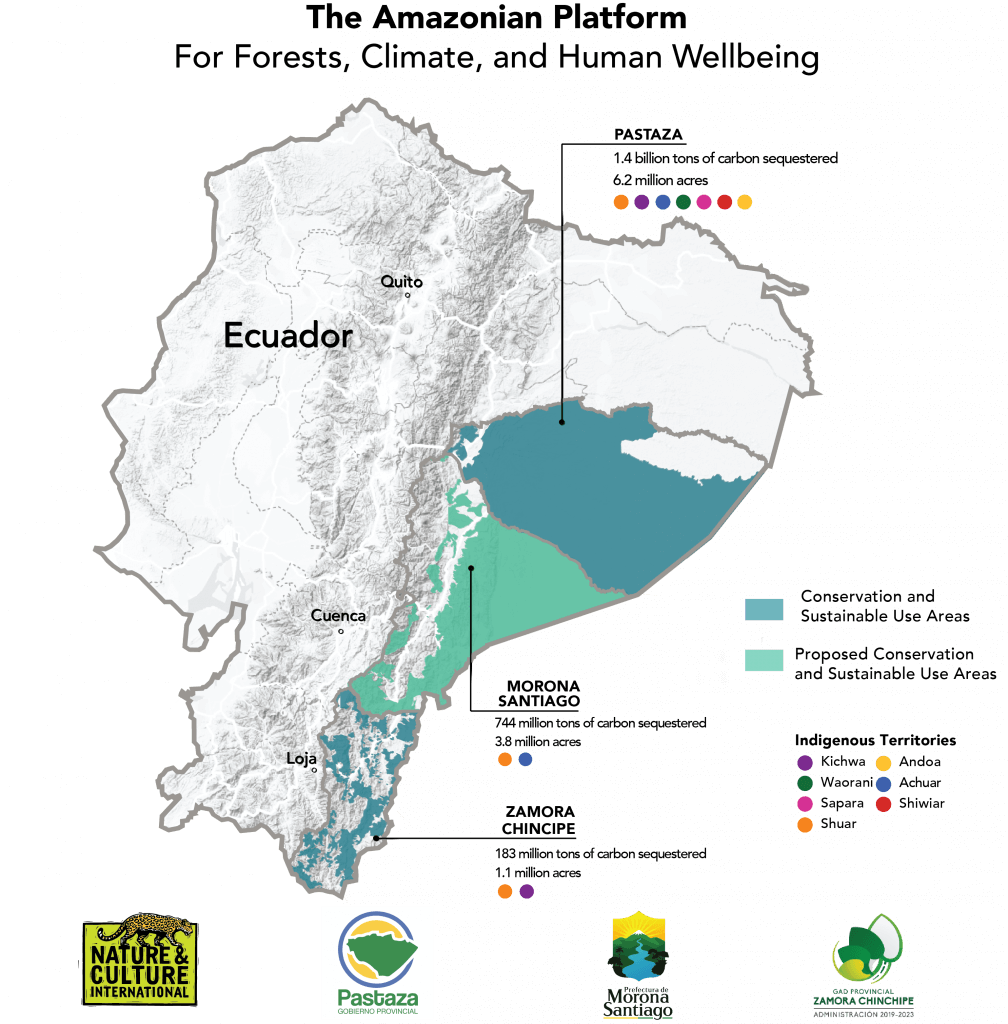Amazonian Platform For Forests, Climate, and Human Wellbeing
03/16/2022
The Amazonian Platform is a partnership linking local governments and Indigenous Nationalities to effectively manage large swaths of the Amazon rainforest.
The country of Ecuador is home to only about 2% of the Amazon rainforest, and yet the water from this location feeds the entire Amazon basin. Here, the provinces of Pastaza, Zamora Chinchipe, Morona Santiago and seven Indigenous nationalities from the Ecuadorian Amazon have begun to work together to show the world that deforestation and degradation of the largest rainforest on the planet can be reversed.
The Amazonian Platform for Forests Climate and Human Wellbeing is a collaborative agreement among the six provinces of the Ecuadorian Amazon and the Confederation of Indigenous Nationalities of the Amazon of Ecuador. In the first phase of this pact, three provinces are committing to effectively manage and protect 11 million acres of continuous forest (about twice the area of New Jersey), making up the largest biological corridor of continuous forest in Ecuador and sequestering 2.3 billion tons of carbon.

The collective effort between local governments and Indigenous nationalities comes at a critical moment, as threats to the Ecuadorian Amazon from deforestation, mining, agricultural expansion, and development increase daily. With technical assistance from Nature and Culture International, this unification of conservation efforts will set an example for an effective means of protecting more of the Amazon rainforest.
On December 28, 2021, Nature and Culture International and the governors of Morona Santiago, Pastaza, and Zamora Chinchipe signed an agreement that advances the construction of the proposed “Amazonian Platform for Forests, Climate and Human Wellbeing” together with the Indigenous communities. The leadership of these three provinces decided to take a crucial step forward to combat climate change and advance the well-being of their population, based on both progress generated in the field of conservation and agreements made with local and Indigenous Peoples and Nationalities.
This union is a commitment to sustainably manage and protect the largest biological corridor of continuous forest in Ecuador in provincial conservation areas. It will generate opportunities for the implementation of a National Strategy and Provincial Strategies for Climate Change, REDD+ and RIA, including reducing deforestation, restoring degraded areas, implementing sustainable livelihood projects, and management of existing conservation areas, among other initiatives.
7 of the 14 Indigenous Nationalities of the Ecuadorian Amazon – Shuar, Achuar, Kichwa, Waorani, Sápara, Andoa and Shiwiar – these areas are currently protected within the subnational conservation system (as Provincial ACUS – Conservation and Sustainable Use Areas) and cover an area larger than all the protected areas within the National System of Protected Areas of the Ecuadorian Amazon.
This area is also home to an incredible biodiversity of life forms, distributed in 28 Ecosystems officially recognized by the Ecuadorian Ministry of Environment and Water, making it one of the most diverse places in the entire Amazon.
Nature and Culture has supported conservation and management efforts in Pastaza for over ten years.
In 2017, Nature and Culture helped establish the 6.2 million acre Pastaza Ecological Area of Sustainable Development in the central Ecuadorian Amazon region. Shortly after, we supported its participation in the Governors’ Climate and Forests Task Force (GCF); a subnational collaboration between 38 states, provinces, and regions from 11 countries to protect forests, reduce emissions, and promote sustainable development.
Since 2020, Nature and Culture International has worked with the Pastaza government to develop its first REDD+ Implementation Plan jointly with the seven Amazonian nationalities of the province. The REDD+ Implementation plan sets sustainable management goals and opens the door for more climate funding to be sent directly to the region.
In 2021 Pastaza became the first provincial government in the Amazon region to have an Implementation Plan to Reduce Deforestation and Degradation of its forests, which was built together with the seven Amazonian nationalities of the province.
Zamora Chinchipe and Morona Santiago follow suit.
In 2018, with the help of Nature and Culture, Zamora Chinchipe declared a 1.1 million acre provincial protected area and is in the process of building its Implementation Plan to Reduce Deforestation and Degradation of its forests.
In 2021, the governor of Mornona Santiago signed an agreement with the Shuar and Achuar Indigenous nationalities to declare the proposed 2.5 million acres of Conservation and Sustainable Use Areas. This sets the stage for these two provincial governments to follow in Pastaza’s footsteps and implement REDD+ plans of their own. Soon, both Zamora Chinchipe and Morona Santiago, will also be part of the GCF Task Force.


